ArkaeVision VR Game: User Experience Research between Real and Virtual Paestum
Abstract
:1. Introduction. User Experience Research in cultural heritage
- -
- See-through and monitor-based AR displays provide users the illusion of admiring no more visible elements of the past, for example columns or colors, directly on the archaeological remains through the juxtaposition of the virtual model on the visible item by means of a device (tablet or a semi-transparent display). In case of holograms, the virtual contents are displayed thanks to an illusory technique better known as Pepper’s Ghost which uses a game of reflections to project virtual elements (images or videos) from a display on a transparent glass, Plexiglas or other plastic film to give the illusion that these elements appear inside environments and interact with objects or physical persons. In addition, the HoloLens technology is based on this approach: this wearable device indeed offers stereoscopic fruition while maintaining an overview on the real word. In case of AR displays using tablets, the system works applying superimposition or juxtaposition of virtual images and real ones framed by the camera of the device [5].
- -
- Multi-projections allow the superimposition of virtual elements (lights, images or videos) directly on real surfaces and physical structures, through projections mapping techniques and letting them coincide. Users are here at the center of a visual show which, in some cases, gives them the impression of being surrounded by ancient elements like architectures of a Greek temple or a Basilica at 1:1 scale, as they would have appeared in origin; alternatively, users can participate to a digital storytelling taking place around them on a very big surfaces, generally supported by open-air soundscape.
- -
- Head-mounted displays (HMD) are the most powerful in terms of immersion into virtual worlds, thanks to a total visual occlusion of users while wearing such devices, as well as a complete sound isolation due to the incorporated earphones; virtual scenes happen in front of users’ eyes, but at a greater level of embodiment: they can see their bodies transposed into the 3D scene and they can directly interact with the digital elements as in real life–by touching, manipulating and moving them using hand devices, as well as walking.
1.1. See, Feel, Remember the Past: Which Connection?
- -
- passive learning
- -
- active learning
- -
- Point of interest. Users can be free to watch anywhere within the virtual scene. It is very important for researchers to study how to structure the simulated space and how to attract the users’ attention to certain spots. Recently, experimentations on sound recognition and visual cues are exploiting new modalities to address users’ eyes and make them move along a predetermined pathway.
- -
- Orientation in virtual space. It is necessary to provide users information that allow them to orient in VR by defining static and dynamic elements in the scene.
1.2. Digital Technologies and (New) Experiences of CH
- the structural and ergonomic aspect of the technological solution, therefore relating to its physical accessibility (Can it be used by all users?), its technical components, its size (e.g., tablet vs. holographic showcase) and its location in physical space (e.g., desktop-based system vs. projections);
- the content of the technological solution, the language used, as well as its level of science and style;
- the interface design of the technological solution, its visual aspect, the recognizable elements (e.g., icons, written texts, images, visual effects), their position, size and logical coherence in order to be appealing and attractive to the final users;
- the possibility of interaction, the models of usage of the technological solution, the logic that underlies the accessibility of contents, their relationship, the possibility of having single or multiple interactions creating participatory experiences also with other users.
2. Experience of the Past and the Present through Gamified Perceptive Storytelling
2.1. Historical Background: The Temple of Hera II and the Poseidonia’s Landscape
2.2. Sacredness, Devotion, Surrealism
2.2.1. Goddess Hera
2.2.2. Priestess of the Temple
3. Virtual into Real. The ArkaeVision Project
- introducing elements of spectacularization during the immersive VR experience recalling the attention of users on the archaeological sites and the objects exposed at Paestum;
- developing new forms of enculturation based on the stimulation of intimate feelings and emotions, which will presumably help users see, feel and, finally, relive the past.
- creating an infrastructure capable of expanding the museum supply, enhancing its visibility, putting in connection places with artifacts while promoting participatory and social dynamics.
3.1. ArkaeVision Archeo: Game-Oriented Components
3.1.1. Mechanism
3.1.2. Strategies
- -
- Help. Digital actor’s assistance, tips, initial tutorial, warning messages are presented in order to assist users during VR exploration and make feel them as autonomous as possible.
- -
- Storytelling. Cut scenes, leading stories, parallel stories, deepening and visual metadata are presented in order to support users’ comprehension of what they see, feel and “touch” in the VR environment.
- -
- Measuring goals. Achievements, performance records, score, success levels, timing are recorded by the system and visualized by users during VR exploration, in order to motivate them to proceed with the story. Such goals are useful in the further phase of ArkaeVision Archeo experience, when users access the web portal: they can consult the explored VR areas, the listened stories and see what they have missed [85].
- -
- Scoring. Quizzes can be found during VR exploration; they positively influence the information retention, “forcing” users to recall at their attention data just acquired and elaborate them so to answer the quizzes [89], by using the head controllers. These quizzes are set in some points of VR exploration to stimulate users’ attention and memorability; related scores can be consulted when users access the ArkaeVision web portal and they can be useful to measure the level of deepness of the experience done, and the quantity and quality of information collected.
3.1.3. Objectives
- -
- Narration. Completion of a narrative-based challenge, create/discover a narrative node, know the story and reach the end of the VR experience.
- -
- Interaction. Users follow the narration thanks to the guide, the priestess Ariadne, who poses questions, quizzes and push them to specific areas of the VR environment. Users can do what they are require to, by addressing the gaze in the right direction or using the hand controllers (point-and-click technique).
3.2. ArkaeVision: Design of the Immersive Virtual Experience
3.3. ArkaeVision: Aesthetics and Visual 3D Modeling
3.3.1. D Modeling
- -
- the exclusive usage of polygonal modeling techniques instead of other more CAD oriented methods exploiting parametric surfaces (e.g., NURBS/Spline modeling);
- -
- no subdivision surfaces used to increase the polygonal resolution;
- -
- no more than 64,000 vertices allowed for each single component;
- -
- UV coordinates ranging between 0 and 1 (no UDIM UV Mapping supported);
- -
- low textures number with atlas-based texture management approach;
- -
- hierarchically linked meshes according to topological components arrangement, enabling visually realistic motion through kinematic chains;
- -
- compliance to conventions regarding labeling of local axes and their positive direction.
3.3.2. Characters
- -
- Philological analysis phase: the development of digital actor representing Ariadne required an accurate research and study’s phases to characterize a well-defined personality with an identifiable behavior in the historical era.
- -
- Pre-production phase: creatives and developers studied the features of the character, aimed at accurately identifying the aesthetic characteristics of the digital actor from an ethnic/anatomic point of view as well as for what was related to its aesthetic details (dress, jewelry, hairstyle).
- -
- Acting and directing phase: last phase was the Ariadne’s characterization from the acting point of view. Phrases, movements and expressiveness were minutely analyzed and appropriately interpreted by the actress who played the part, subsequently transferred, through Performance Capture techniques, to the CGI character.
3.4. ArkaeVision: Learning Analytics
- -
- The level of users’ attention, memorization and elaboration [8,96]; these three, at the end of the project, should lead to a clearer vision of the potential inherent in the immersive VR application regarding:
- knowledge acquisition (understanding and learning)
- acquisition of certain skills based on newly acquired knowledge (experience)
- knowledge retention (storage and processing)
- -
- The receptivity of users, i.e., the faculty to perceive and beware of specific visual inputs, verbal suggestions and, etc., scenario after scenario, along the VR exploration [7].
- -
- The users’ emotional response, i.e., the reaction to environmental stimuli, so to respond in a condescending or spontaneous way [7].
- -
- Finally, on a psychomotor level [97], the basic movements that users perform are considered significant as well as the dexterity of the movements, i.e., the ability to adapt to a virtual or alternative scenario.
3.4.1. Learning Mechanism
3.4.2. Learning Actions
3.4.3. Learning Tools
- -
- Information graphics—art, graphics, illustrations, drawings, 3D effects;
- -
- Textual information—metadata of 3D elements (age, provenance, dimensions,), analogies, definitions, historical facts, list of activities to be carried out;
- -
- Multimedia—animation, cinema, speeches, videos, 3D models, evocations;
- -
- Problem-solving—narrative nodes and crossroads, puzzles, challenges.
4. UX Evaluations
- -
- An interactive area of about 3 × 4 m where users can physically move, indicated by a PVC black/blue carpet, a web tensioner, tables and chairs;
- -
- A workstation dedicated to ArkaeVision Archeo with PC, Monitor 55 inches, HTC Vive viewer and trackers;
- -
- A remote station for assistant/technician useful to guide users throughout the experience with PC and Monitor—27 inches.
4.1. Goals and Methodology
- A.
- The effectiveness of the way of experiencing the content—by means of an immersive viewer and hand controllers. The authors want to understand if the system is usable and the quality of users’ interaction—as immediately and natural as possible.
- B.
- The emotional component of VR interactive exploration. Emotions in ArkaeVision Archeo should help the learning process to be activated [98,99] by analyzing the narrative nodes and how they were stimulated, how long users listened to them and which one they have selected. This information may lead authors to understand any correlation between time spent with the VR application and emotive state of users, level of emotional involvement and quality of information remembered, type of actions performed, and type of information remembered.
- C.
- The involvement of users through a gamified perceptive storytelling. It is true that to increase the user’s engagement gaming-like techniques are advisable: choose a goal to be reached within the virtual exploration, such as moving to the next level of the story; unlock some narrative nodes; meet a virtual character like Ariadne in the temple… these cause a strong motivation in the users, who are very effective in focusing and concentrating on completing a task and bringing self-confidence. Such kind of experience in ArkaeVision Archeo should therefore encourage users’ content understanding.
- -
- Observation: it is one of the most used at the beginning of each evaluative activity, although it is not always easy to conduct [101]; it is extremely useful as it provides fertile ground for the first considerations on users and technologies and for constructing the conceptual map for the investigative comparison of the results obtained by direct survey tools. Observations are not used only at the beginning of the evaluation, but also during the user experience.
- -
- Questionnaire: it is essential to probe the basic knowledge of each user to identify the needs and expectations, recognize the attitudes, gestures, movements and comments [102]. The questionnaire is widely used in research and it is built upon the goal to be pursued (type of questions, modulation of sentences, language’s level), and the function it must have in the context of the project to be evaluated (usability test or demographic interest, customer satisfaction or cognitive learning, etc.); users can fill in the questionnaire independently, with a certain margin of expression.
- -
- Demographics. Age, gender, provenance, educational background, technological alphabetization, profession; preferences on the type of cultural visit (alone or in group; for working reason or with families); preferences on the type of technological device used; time spent with such a device; reasons to visit cultural site; average amount of budget assigned to cultural experiences.
- -
- User experience. Usability, efficiency and performances of the product; users’ preferences about the aesthetical features of VR; timing of VR exploration; users’ sense of immersion in the VR environment; users’ comfortless using the viewer and the hand controllers; intuitiveness of functions and their practice; naturalness and practicability of the interaction modes, any sense of tiredness during VR exploration; any locomotion effect.
- -
- Emotional sphere. Overall sense of embodiment with the VR world, sense of involvement, preferences of the VR application (style, colors and general atmosphere, storytelling, interaction with character, sense of immersion).
- -
- Learning outcomes. Users’ memory about the exact period of time traveling, the name of the goddess in the temple, the name of the Priestess, the number of columns of the temple, the genealogy of the Goddess, the correct votive objects loved by the goddess and why, the myth of the Milky road, the place where the sacrifices happened, who could participate at these sacrifices.
- -
- Dissemination. How users image the appliance of the VR application in museums or schools, if users would suggest this type of experience to others, what they would better and what they would change at all, how much would they pay for such a VR immersive experience.
- -
- Userexperience. Relationship between users and the technological tool; naturalness and intuitiveness of the viewer and the controllers’ usage, naturalness of interaction and gestures required by the system; any sense of satisfaction in reaching goals into VR exploration; any sense of curiosity and interest to proceed with the experience.
- -
- Cognitive sphere. Difficulties in facing challenges and tasks to be accomplished during VR exploration; issues related to the storyline; issues related to connections between items, stories and tasks to be accomplished; preferences about aesthetics of images; any sense of realism, any parallelism with users’ everyday life.
- -
- Emotional sphere. Overall sense of embodiment with the VR world, sense of involvement, emotions felt during the VR experience and why (free answer), what users liked the most and what users disliked of the VR experience.
- -
- Users’ level of comfort. Users’ behavior, gestures and actions in relation with the viewer and the hand controllers; any locomotion effect.
- -
- Users’ level of attention. Users’ capacity to follow the storytelling and the “spatial metadata” appearing in some places of the VR environment; directions where users addressed their attention; time spent listening to the stories; remembering of actions to be performed to accomplish certain tasks or interactions.
- -
- Verbal and non-verbal communication of users. facial expressions, gestures, virtual proximity, virtual touch, eye contact. The operator could take notes of these aspects by direct observing the users and also the monitor where users’ head movements were registered. In such a way, it was possible to understand where they were looking at, any indecision in the movements or actions.
4.2. Logistics and Conduction
4.3. Results of the UX Evaluations
- -
- time shifting and the chance to go back in time (24% out of the global users);
- -
- the high fidelity of forms and architectures (14% out of the global users);
- -
- the natural interaction and the immediateness of system’s feedback (13% out of the global users);
- -
- the general atmosphere recreated through colors, sounds and style of the virtual scenes (15% out of the global users).
- -
- the global atmosphere made of colors, sounds and historical setting (22% in Paestum and 28% in Florence);
- -
- the sense of immersion and the perceptive sensation of “being projected” into another world (25% in Paestum and 20% in Florence);
- -
- the vedutismo pictorial style and the “sense of ancient” in the graphic details (17% in Paestum and 23% in Florence);
- -
- more, the scenography, with its particular forms and characters (21% in Paestum and 18% in Florence).
5. Discussion
5.1. Interactive Immersive Experience (Goal A)
5.1.1. Embodiment and Immersion in Virtual Poseidonia
5.1.2. “Invisibility” of HMD Technology
5.2. Emotional Experience (Goal B)
- A.
- Emotional content. The sight of a beautiful landscape, the presence of faces, a gradient of warm color, let strong emotions arise–as users affirmed during the UXEs—and they allow a profitable memorization—given the high percentage of correct answers about the historical content;
- B.
- Presence of action. If there is an evolving action in the virtual image, then our brain almost unconsciously foreshadows the development of what will happen. This allows a greater emotional involvement of users in the scene they are watching at. Operators noticed an interesting relationship between the emotive state of users and their performances during the VR experience: the more users were positive and proactive towards specific tasks, the more they remembered visual details and “geo-referred” facts (units of information placed in specific points of the VR environment).
- C.
- Observation perspective. The user’s point of view with respect to visualization is relevant for emotional involvement and, therefore, guaranteeing a visual memory. The more the users’ position is central to the virtual scene they are observing, the more their perception and sense of presence are vivid; in fact, by privileging a central point of view, like in ArkaeVision Archeo, users had the opportunity to grasp both the sense of the whole and the multiple details, thus having the chance to remember more effectively the “photography” of that specific experience-as the investigated users confirmed with their descriptions.
5.3. Digital Characters & Storytelling (Goal C)
“Real” Characters and Sense of Dialog
6. Conclusions & Future Perspectives
Author Contributions
Funding
Acknowledgments
Conflicts of Interest
References
- Bekele, M.; Champion, E. A Comparison of Immersive Realities and Interaction Methods: Cultural Learning in Virtual Heritage. Front. Robot. AI 2019, 6. [Google Scholar] [CrossRef] [Green Version]
- Drossis, G.; Birliraki, C.; Stephanidis, C. Interaction with Immersive Cultural Heritage Environments Using Virtual Reality Technologies. In Communications in Computer and Information Science; Springer: Berlin/Heidelberg, Germany, 2018; pp. 177–183. [Google Scholar] [CrossRef]
- Galdieri, R.; Carrozzino, M. Natural Interaction in Virtual Reality for Cultural Heritage. In VR Technologies in Cultural Heritage. VRTCH 2018; Communications in Computer and Information Science; Duguleană, M., Carrozzino, M., Gams, M., Tanea, I., Eds.; Springer: Berlin/Heidelberg, Germany, 2019; Volume 904. [Google Scholar]
- Pietroni, E.; Pagano, A.; Fanini, B. UX Designer and Software Developer at the mirror: Assessing sensory immersion and emotional involvement in Virtual Museums. In Special Issue of "Studies in Digital Heritage" on "Perceiving Cultural Heritage through Digital Technologies"; Indiana University: Bloomington, Indiana, 28 February 2018; pp. 13–41. [Google Scholar]
- Pietroni, E.; Ferdani, D.; Forlani, M.; Pagano, A.; Rufa, C. Bringing the Illusion of Reality Inside Museums—A Methodological Proposal for an Advanced Museology Using Holographic Showcases. J. Inform. 2019, 6. [Google Scholar] [CrossRef] [Green Version]
- Kolb, D. Experiential Learning: Experience as the Source of Learning and Development; Prentice Hall: Englewood Cliffs, NJ, USA, 1984. [Google Scholar]
- Bloom, B.B.; Krathwohl, D.R.; Masia, B.B. Handbook II. Affective Domain; David McKay Company: New York, NY, USA, 1957. [Google Scholar]
- Bloom, B.S. Reflections on the development and use of the taxonomy. In Bloom’s Taxonomy: A Forty-year Retrospective, Yearbook of the National Society for the Study of Education; Anderson, L.W., Sosniak, L.A., Eds.; National Society for the Study of Education: Chicago, IL, USA, 1994; Volume 93, ISSN 1744-7984. [Google Scholar]
- Bloom, B.S.; Engelhart, M.D.; Furst, E.J.; Hill, W.H.; Krathwohl, D.R. Taxonomy of educational objectives: The classification of educational goals. In Handbook I: Cognitive Domain; David McKay Company: New York, NY, USA, 1956. [Google Scholar]
- Raptis, G.E.; Fidas, C.; Avouris, N. Do Game Designers’ Decisions Related to Visual Activities Affect Knowledge Acquisition in Cultural Heritage Games? An Evaluation From a Human Cognitive Processing Perspective. J. Comput. Cult. Herit. 2019, 12, 1–25. [Google Scholar] [CrossRef]
- Sternberg, R.J.; Sternberg, K. Cognitive Psychology; Wadsworth Cengage Learning: Belmont, CA, USA, 2009. [Google Scholar]
- Antinucci, F. Comunicare nel Museo; Laterza: Bari, Italy, 2014. [Google Scholar]
- Antinucci, F. Parola e Immagine; Storia di due Tecnologie; Laterza: Bari, Italy, 2011. [Google Scholar]
- Konstantakis, M.; Caridakis, G. Adding Culture to UX: UX Research Methodologies and Applications. J. Comput. Cult. Herit. 2020, 13, 1–17. [Google Scholar] [CrossRef] [Green Version]
- Gockel, B.; Graf, H.; Pagano, A.; Pescarin, S.; Eriksson, J. VMUXE. An Approach to User Experience Evaluation for Virtual Museums. In Design, User Experience, and Usability. Design Philosophy, Methods, and Tools; DUXU 2013. Lecture Notes in Computer Science; Marcus, A., Ed.; Springer: Berlin/Heidelberg, Germany, 2013; Volume 8012, pp. 262–272. [Google Scholar]
- Ashworth, M.; Argote, L.; Mukhopadhyay, T. The Effect of Information Technology on Knowledge Acquisition, Retention, and Transfer. In Proceedings of the 25th Annual International Conference on Information Systems (ICIS), Milwaukee, WI, USA, 10–13 December 2006; pp. 11–21. [Google Scholar]
- Markovic, G.; Vukovac, M.P.; Klicek, B. A Study on Knowledge Gain and Retention when Using Multimedia Learning Materials of Different Quality. J. Inf. Organ. Sci. 2015, 39, 33–48. [Google Scholar]
- Elhachemi, T.; Saoula, O.; Elkheloufi, A.; Benabid, E. Towards A Better Understanding of the Antecedents of Knowledge Acquisition and Its Outcome: A Two- Fold Proposed Framework. Test Eng. Manag. 2020, 82, 1957–1971. [Google Scholar]
- Roberts, J. Chapter 4: Knowledge Acquisition, Retention, and Transfer. In A Very Short, Fairly Interesting and Reasonably Cheap Book about Knowledge Management; Sage: Thousand Oaks, CA, USA, 2008. [Google Scholar] [CrossRef]
- Pagano, A.; Pietroni, E.; Poli, C. An integrated methodological approach to evaluate virtual museums in real museum contexts. In Proceedings of the 9th Annual International Conference of Education, Research and Innovation (ICERI), Seville, Spain, 14–16 November 2016; ISBN 978-84-617-5895-1. [Google Scholar]
- Pietroni, E.; Pagano, A.; Amadei, M.; Galiffa, F. Livia’s Villa Reloaded Virtual Museum: User Experience Evaluation. In Proceedings of the 9th annual International Conference of Education, Research and Innovation (ICERI), Seville, Spain, 14–16 November 2016; ISBN 978-84-617-5895-1. [Google Scholar]
- Cipresso, P.; Giglioli, I.A.C.; Raya, M.A.; Riva, G. The Past, Present, and Future of Virtual and Augmented Reality Research: A Network and Cluster Analysis of the Literature. Front. Psychol. 2018, 9, 2086, PMID: 30459681, PMCID: PMC6232426. [Google Scholar] [CrossRef] [PubMed] [Green Version]
- Au, E.H.; Lee, J.J. Virtual reality in education: A tool for learning in the experience age. Int. J. Innov. Educ. 2017, 4, 215. [Google Scholar] [CrossRef]
- Rizvic, S.; Boskovic, D.; Okanovic, V.; Sljivo, S.; Zukic, M. Digital Storytelling. In Visual Computing for Cultural Heritage; Liarokapis, F., Voulodimos, A., Doulamis, N., Doulamis, A., Eds.; Springer: Berlin/Heidelberg, Germany, 2020; pp. 347–367. [Google Scholar] [CrossRef]
- Sylaiou, S.; Dafiotis, P. Storytelling in Virtual Museums: Engaging A Multitude of Voices. In Visual Computing for Cultural Heritage; Liarokapis, F., Voulodimos, A., Doulamis, N., Doulamis, A., Eds.; Springer: Berlin/Heidelberg, Germany, 2020; pp. 369–388. [Google Scholar] [CrossRef]
- Mackay, D.G.; Shafto, M.; Taylor, J.K.; Marian, D.E.; Abrams, L.; Dyer, J.R. Relations between emotion, memory, and attention: Evidence from taboo Stroop, lexical decision, and immediate memory tasks. Mem. Cogn. 2004, 32, 474–488. [Google Scholar] [CrossRef] [Green Version]
- Flaisch, T.; Steinhauser, M.; Schupp, H.T. Adaptive cognitive control attenuates the late positive potential to emotional distractors. NeuroImage 2019, 200, 51–58. [Google Scholar] [CrossRef]
- Schubring, D.; Schupp, H. Emotion and attention effects as revealed by brain oscillations. In S. Schindler (Chair), Electrocortical Responses in Emotion Processing: Insights From Healthy Participants, Amygdala-Resection and Psychopathological Patients. Symposium Conducted at the Meeting of the Society of Psychophysiological Research; Society for Psychophysiological Research: Washington, DC, USA, 2019. [Google Scholar]
- Schupp, H.T.; Stockburger, J.; Codispoti, M.; Junghöfer, M.; Weike, A.I.; Hamm, A.O. Selective Visual Attention to Emotion. J. Neurosci. 2007, 27, 1082–1089. [Google Scholar] [CrossRef] [PubMed]
- Smith, S.D.; Most, S.B.; Newsome, L.A.; Zald, D.H. An emotion-induced attentional blink elicited by aversively conditioned stimuli. Emotion 2006, 6, 523–527. [Google Scholar] [CrossRef] [PubMed] [Green Version]
- Walker, W.R.; Skowronski, J.J.; Gibbons, J.A.; Vogl, R.J.; Ritchie, T. Why people rehearse their memories: Frequency of use and relations to the intensity of emotions associated with autobiographical memories. Memory 2009, 17, 760–773. [Google Scholar] [CrossRef] [PubMed]
- Skowronski, J.J.; Walker, W.R.; Henderson, D.X.; Bond, G.D. Chapter Three—The Fading Affect Bias: Its History, Its Implications, and Its Future. In Advances in Experimental Social Psychology; Academic Press: Cambridge, MA, USA, 2014; Volume 49, pp. 163–218. [Google Scholar] [CrossRef]
- Lenzi, L. Neurofisiologia e Teorie Della Mente; Vita e Pensiero: Milan, Italy, 2005. [Google Scholar]
- Zan, R. Il ruolo cruciale del pensiero narrativo nella comprensione dei problemi. Didattica Della Mat. Dalla Ric. Alle Prat. D’aula 2017, 46–57. [Google Scholar] [CrossRef]
- Dugan, J.E. Audio-Visual Methods in Teaching; The Dryden Press: New York, NY, USA, 1955. [Google Scholar] [CrossRef]
- Jackson, J. Myths of Active Learning: Edgar Dale and the Cone of Experience. J. Hum. Anat. Physiol. Soc. 2016, 20, 51–53. [Google Scholar] [CrossRef]
- McClusky, H.Y. The Content of Motion Pictures. Edgar DaleChildren’s Attendance at Motion Pictures. Edgar Dale. Elem. Sch. J. 1936, 36, 552–553. [Google Scholar] [CrossRef]
- Subramony, D.; Molenda, M.; Betrus, A.; Thalheimer, W. The Mythical Retention Chart and the Corruption of Dale’s Cone of Experience. Educ. Technol. 2014, 54, 6–16. [Google Scholar]
- Fòrema. Experiential Learning. Metodi, Tecniche E Strumenti per IL Debriefing: Metodi, Tecniche E Strumenti per IL Debriefing; FrancoAngeli: Milan, Italy, 2015. [Google Scholar]
- Moon, J.A. A Handbook of Reflective and Experiential Learning: Theory and Practice; Routledge: New York, NY, USA, 2004. [Google Scholar]
- Piaget, J. Avviamento al Calcolo; La Nuova Italia: Firenze, Italy, 1956. [Google Scholar]
- McQueen, B.; Nowak, A.; Kjaer Olsen, J. Learning by Doing in 3D Environments: Collaborative Efforts in Second Life and OpenSim. In Handbook of Research on Collaborative Teaching Practice in Virtual Learning Environments; IGI Global: Hershey, PA, USA, 2017. [Google Scholar]
- Alais, D.; Newell, F.; Mamassian, P. Multisensory Processing in Review: From Physiology to Behaviour. Seeing Perceiving 2010, 23, 3–38. [Google Scholar] [CrossRef] [Green Version]
- Ferré Veciana, J.; Aribau Montón, E. El Desarrollo Neurofuncional Del NIño y Sus Trastornos. Visión, Aprendizaje y Otras Funciones Cognitivas; Ediciones Lebón: Barcelona, Spain, 2008. [Google Scholar]
- Hellier, J.L. Congenital insensitivity to pain. In The Five Senses and Beyond: The Encyclopedia of Perception; Hellier, J.L., Ed.; Greenwood: Santa Barbara, CA, USA, 2016; pp. 118–119. [Google Scholar]
- Hutmacher, F. Why Is There So Much More Research on Vision Than on Any Other Sensory Modality? Front. Psychol. 2019, 10, 2246. [Google Scholar] [CrossRef]
- Katifori, A.; Tsitou, F.; Pichou, M.; Kourtis, V.; Papoulias, E.; Ioannidis, Y.; Roussou, M. Exploring the Potential of Visually-Rich Animated Digital Storytelling for Cultural Heritage. In Visual Computing for Cultural Heritage; Liarokapis, F., Voulodimos, A., Doulamis, N., Doulamis, A., Eds.; Springer: Berlin/Heidelberg, Germany, 2020; pp. 325–345. [Google Scholar] [CrossRef]
- Stokes, D.; Biggs, S. The dominance of the visual. In Perception and its Modalities; Stokes, D., Matthen, M., Biggs, S., Eds.; Oxford University Press: Oxford, UK, 2014; pp. 350–378. [Google Scholar]
- Foni, A.E.; Papagiannakis, G.; Magnenat-Thalmann, N. A taxonomy of visualization strategies for cultural heritage applications. J. Comput. Cult. Herit. 2010, 3, 1–21. [Google Scholar] [CrossRef]
- Alexander, A.L.; Brunyé, T.; Sidman, J.; Weil, S.A. From Gaming to Training: A Review of Studies on Fidelity, Immersion, Presence, and Buy-in and Their Effects on Transfer in PC-Based Simulations and Games; Aptima, Inc.: Woburn, MA, USA, 2005. [Google Scholar]
- Ibrahimi, D. La Visione in Relazione ai Problemi di Apprendimento nella Lettura. In NEUROSCIENZE, Rivista Online. 27 April 2012. Available online: https://www.neuroscienze.net/wp-content/uploads/2012/04/La-Visione-in-Relazione-ai-Problemi-di-Apprendimento-nella-Lettura.pdf (accessed on 23 December 2019).
- Davis, K.; Christodoulou, J.; Seider, S.; Gardner, H. The Theory of Multiple Intelligences. In The Cambridge Handbook of Intelligence; Sternberg, R.J., Kaufman, B., Eds.; Cambridge University Press: Cambridge, UK, 2011; pp. 485–503. ISBN 978-0521518062. [Google Scholar]
- Gardner, H. Multiple Intelligences: New Horizons in Theory and Practice; Basic Books: New York, NY, USA, 2006; ISBN 978-0465047680. [Google Scholar]
- Roussou, M. Immersive Interactive Virtual Reality in the Museum. In Proceedings of the TiLe, Foundation of The Hellenic World, Product, Greece, 6–9 June 2002; p. 2. [Google Scholar]
- Öhman AMineka, S. Fears, Phobias, and Preparedness: Toward and Evolved Module of Fear and Fear Learning. Psychol. Rev. 2001, 108, 483–522. [Google Scholar] [CrossRef] [PubMed] [Green Version]
- Shafer, D.; Carbonara, C.P.; Korpi, M.F. Factors Affecting Enjoyment of Virtual Reality Games: A Comparison Involving Consumer-Grade Virtual Reality Technology. Games Health J. 2019, 8, 15–23. [Google Scholar] [CrossRef] [PubMed]
- Boletsis, C. The New Era of Virtual Reality Locomotion: A Systematic Literature Review of Techniques and a Proposed Typology. Multimodal Technol. Interact. 2017, 1, 24. [Google Scholar] [CrossRef] [Green Version]
- Bozgeyikli, E.; Raij, A.; Katkoori, S.; Dubey, R. Point & teleport locomotion technique for virtual reality. In Proceedings of the 2016 Annual Symposium on Computer-Human Interaction in Play, Austin, TX, USA, 15 October 2016; pp. 205–216. [Google Scholar]
- Mortara, M.; Catalano, C.E.; Bellotti, F.; Fiucci, G.; Houry-Panchetti, M.; Petridis, P. Learning cultural heritage by serious games. J. Cult. Herit. 2014, 15, 318–325. [Google Scholar] [CrossRef] [Green Version]
- Truby, J. Anatomy of a Story; Faber and Faber: London, UK, 2007. [Google Scholar]
- Mortara, M.; Catalano, C. 3D Virtual environments as effective learning contexts for cultural heritage. Ital. J. Educ. Technol. 2018, 26, 5–21. [Google Scholar]
- Doukianou, S.; Daylamani-Zad, D.; Paraskevopoulos, I. Beyond Virtual Museums: Adopting Serious Games and Extended Reality (XR) for User-Centred Cultural Experiences. In Visual Computing for Cultural Heritage; Liarokapis, F., Voulodimos, A., Doulamis, N., Doulamis, A., Eds.; Springer: Berlin/Heidelberg, Germany, 2020; pp. 283–299. [Google Scholar] [CrossRef]
- Fassone, R. Cinema e Videogiochi; Carocci: Rome, Italy, 2017. [Google Scholar]
- Anderson, E.F.; McLoughlin, L.; Liarokapis, F.; Peters, C.; Petridis, P.; De Freitas, S. Developing serious games for cultural heritage: A state-of-the-art review. Virtual Real. 2010, 14, 255–275. [Google Scholar] [CrossRef] [Green Version]
- Dickey, M.D. Game Design Narrative for Learning: Appropriating Adventure Game Design Narrative Devices and Techniques for the Design of Interactive Learning Environments. Educ. Technol. Res. Dev. 2006, 54, 245–263. [Google Scholar] [CrossRef]
- Palombini, A. Storytelling and telling history. Towards a grammar of narratives for Cultural Heritage dissemination in the Digital Era. J. Cult. Herit. 2017, 24, 134–139. [Google Scholar] [CrossRef]
- Greco, E. Paestum. La Città Dei Tre Templi; Vision: Roma, Italy, 2019. [Google Scholar]
- Torelli, M. Paestum Romana. Ingegneria per la Cultura; Marsilio Editore: Roma, Italy, 1999. [Google Scholar]
- Zuchtriegel, G. Colonization and Subalternity in Classical Greece: Experience of the Non-Elite Population; Cambridge University Press: Cambridge, UK, 2017. [Google Scholar]
- Zuchtriegel, G. Piranesi a Paestum. Il Suono dell’architettura; Artém: Napoli, Italy, 2017. [Google Scholar]
- Mertens, D. I templi di Paestum paradigmi per lo studio dell’architettura classica. In Architettura Pubblica E Privata Nell’Italia Antica; Quilici, L., Quilici Gigli, S., Eds.; Gangemi: Roma, Italy, 2007; pp. 143–161. [Google Scholar]
- Biraschi, A.M. Strabone, Geografia: L’Italia, Book V, VI; BUR Rizzoli: Milano, Italy, 1988; ISBN 88-17-16687-1. [Google Scholar]
- Greco, E.; Greco, G.; Pontrandolfo, A. Da Poseidonia a Paestum; (Paestum. La Città e il Museo 2); Ingegneria Della Cultura: Roma, Italy, 2002. [Google Scholar]
- De La Genière, J.; Greco, G. (Eds.) Il Santuario di Hera alla Foce del Sele. Indagini e studi 1987–2006; Società Magna Grecia: Roma, Italy, 2010; Volume 1. [Google Scholar]
- Zuchtriegel, G. Il tempio di Nettuno tra emblema e caso di studio. In "L’EMBLEMA DELL’ETERNITÀ". Il tempio di Nettuno a Paestum tra Archeologia, Architettura e Restauro; Mangone, F., Russo, V., Zuchtriegel, G., Eds.; ETS: Pisa, Italy, 2019; pp. 13–26. [Google Scholar]
- Zuchtriegel, G. Da Poseidonia a Paestum: Archeologia di un nome. In Dialogando. Studi in Onore di Mario Torelli; Masseria, C., Marroni, E., Eds.; ETS: Pisa, Italy, 2017; pp. 469–477. [Google Scholar]
- Rescigno, C. Tra il tempio di Nettuno e la Basilica: Osservazioni sul corpus delle terrecotte architettoniche pestane. In "L’EMBLEMA DELL’ETERNITÀ". Il tempio di Nettuno a Paestum tra Archeologia, Architettura e Restauro; Mangone, F., Russo, V., Zuchtriegel, G., Eds.; ETS: Pisa, Italy, 2019; pp. 59–72. [Google Scholar]
- Mertens, D. Il tempio di Nettuno alla luce di un nuovo rilievo. In "L’EMBLEMA DELL’ETERNITÀ". Il Tempio dI Nettuno a Paestum Tra Archeologia, Architettura e Restauro; Mangone, F., Russo, V., Zuchtriegel, G., Eds.; ETS: Pisa, Italy, 2019; pp. 27–58. [Google Scholar]
- Cipriani, M. Il ruolo di Hera nel santuario meridionale di Poseidonia. In Héra. Images, Espaces, Cultes. Actes du Colloque International de Lille; OpenEdition: Napoli, Italy, 1993; Volume 15, pp. 211–225. ISBN 9782918887201. [Google Scholar] [CrossRef]
- Hellström, P.; Alroth, B. Religion and Power in the Ancient Greek World. In Proceedings of the Uppsala Symposium 1993; Acta Universitatis Upsaliensis: Stockholm, Sweden, 1996. [Google Scholar]
- Strøm, I. Evidence from the Sanctuaries. In Greece between East and West 10th-8th centuries BC: Papers of the meeting at the Institute of Fine Arts, New York University, March 15th-16th, 1990; Kopcke, G., Tokumaru, I., Eds.; Verlag Philipp von Zabern: Mainz, Germany, 1992; pp. 46–60. [Google Scholar]
- Torelli, M. Il rango, il Rito e L’immagine; Mondadori Electa: Milano, Italy, 1997. [Google Scholar]
- Scarpi, P. La religione greca. In Storia Delle Religioni. Mondo Classico. Europa Pre-Cristiana; Filoramo, G., Ed.; Laterza: Bari, Italy, 2005; pp. 41–151. [Google Scholar]
- Mylonopoulos, J. Greek Sanctuaries as Places of Communication through Rituals: An Archaeological Perspective. In Ritual and Communication in the Graeco-Roman World; OpenEdition: Napoli, Italy, 2006; pp. 69–110. [Google Scholar]
- Bozzelli, G.; Raia, A.; Ricciardi, S.; De Nino, M.; Barile, N.; Perrella, M.; Tramontano, M.; Pagano, A.; Palombini, A. An integrated VR/AR framework for user-centric interactive experience of cultural heritage: The ArkaeVision project. Digit. Appl. Archaeol. Cult. Herit. 2019, 15, e00124. [Google Scholar] [CrossRef]
- Arnab, S.; Lim, T.; Carvalho, M.B.; Bellotti, F.; de Freitas, S.; Louchart, S.; Suttie, S.; Berta, R.; De Gloria, A. Mapping Learning and Game Mechanics for Serious Games Analysis; Wiley: Hoboken, NJ, USA, 2015. [Google Scholar]
- Deterding, S.; Dixon, D.; Khaled, R.; Nacke, L. From Game Design Elements to Gamefulness: Defining “Gamification”. In Proceedings of the 15th International Academic MindTrek Conference: Envisioning Future Media Environments, Tampere, Finland, 6–8 October 2011; pp. 9–15. [Google Scholar] [CrossRef]
- Carvalho, M. Serious Games for Learning: A Model and a Reference Architecture for Efficient Game Development; Tilburg University: Tilburg, The Netherlands, 2017. [Google Scholar]
- Csikszentmihalyi, M. Flow. The Psychology of Optimal Experience; Alpina: Buchloe, Germany, 2011. [Google Scholar]
- Wilhelmsson, U.; Backlund, P. Everyone Is not a Gamer! Developing Cultural Heritage Experiences for Diverse Audiences. In Visual Computing for Cultural Heritage; Liarokapis, F., Voulodimos, A., Doulamis, N., Doulamis, A., Eds.; Springer: Berlin/Heidelberg, Germany, 2020; pp. 263–281. [Google Scholar] [CrossRef]
- Majewski, J. Cultural heritage in role-playing video games: A map of approaches. Furnace 2015, 2, 24–36. [Google Scholar]
- Craig, A.B.; Sherman, W.R.; Will, J.D. Developing Virtual Reality Applications: Foundations of Effective Design; Morgan Kaufmann: Burlington, MA, USA, 2009. [Google Scholar]
- Day, A.M.; Arnold, D.; Havemann, S.; Fellner, D. Combining polygonal and subdivision surface approaches to modelling and rendering of urban environments. Comput. Graph. 2004, 28, 497–507. [Google Scholar] [CrossRef]
- Achenbach, J.; Waltemate, T.; Latoschik, M.E.; Botsch, M. Fast generation of realistic virtual humans. In Proceedings of the 23rd ACM Symposium on Virtual Reality Software and Technology, Gothenburg, Sweden, 8–10 November 2017; pp. 1–10. [Google Scholar]
- Airasian, P.W.; Cruikshank, K.A.; Mayer, R.E.; Pintrich, P.R.; Raths, J.; Wittrock, M.C. A Taxonomy for Learning, Teaching and Assessing: A Revision of Bloom’s Taxonomy of Educational Objectives; Anderson, L.W., Krathwohl, D.R., Eds.; Allyn and Bacon: Boston, MA, USA, 2000; ISBN 978-0-8013-1903-7. [Google Scholar]
- Agazzi, E.; Fortunati, V. Memoria e Saperi; Meltemi Editore Srl: Rome, Italy, 2007. [Google Scholar]
- Dave, R.; Harrow, A.J. Handbook III. Psychomotor Domain; David McKay Company: New York, NY, USA, 1976. [Google Scholar]
- Goleman, D. Emotional Intelligence: Why It Can Matter More Than IQ; Bloomsbury: London, UK, 1995. [Google Scholar]
- Goleman, D. Intelligenza Emotiva. Che Cos’è e Perché Può Renderci Felici; Bur: Milano, Italy, 2011. [Google Scholar]
- Pagano, A.; Armone, G.; De Sanctis, E. Virtual Museums and Audience Studies. The case of Keys To Rome exhibition. In Proceedings of the “Digital Heritage 2015”. International Congress, Granada, Spain, 28 September–2 October 2015. [Google Scholar]
- Kuniavsky, M. Observing The User Experience—A Practitioner’s Guide to User Research; Morgan Kaufmann Publishers: Burlington, MA, USA, 2003. [Google Scholar]
- Garrett, J. Elements of User Experience: User-Centered Design for the Web; New Riders Press: Indianapolis, IN, USA, 2002. [Google Scholar]
- Piaget, J. Development and learning. In Piaget Rediscovered: A Report on the Conference of Cognitive Studies and Curriculum Development; Ripple, R.E., Rockcastle, V.N., Eds.; Cornell University: Ithaca, NY, USA, 1964; pp. 7–20. [Google Scholar]
- Palombini, A. Narrazione e virtualità: Possibili prospettive per la comunicazione museale. Digit. WEB 2012, 1, 9–22, ISSN: 1972-6201. [Google Scholar]
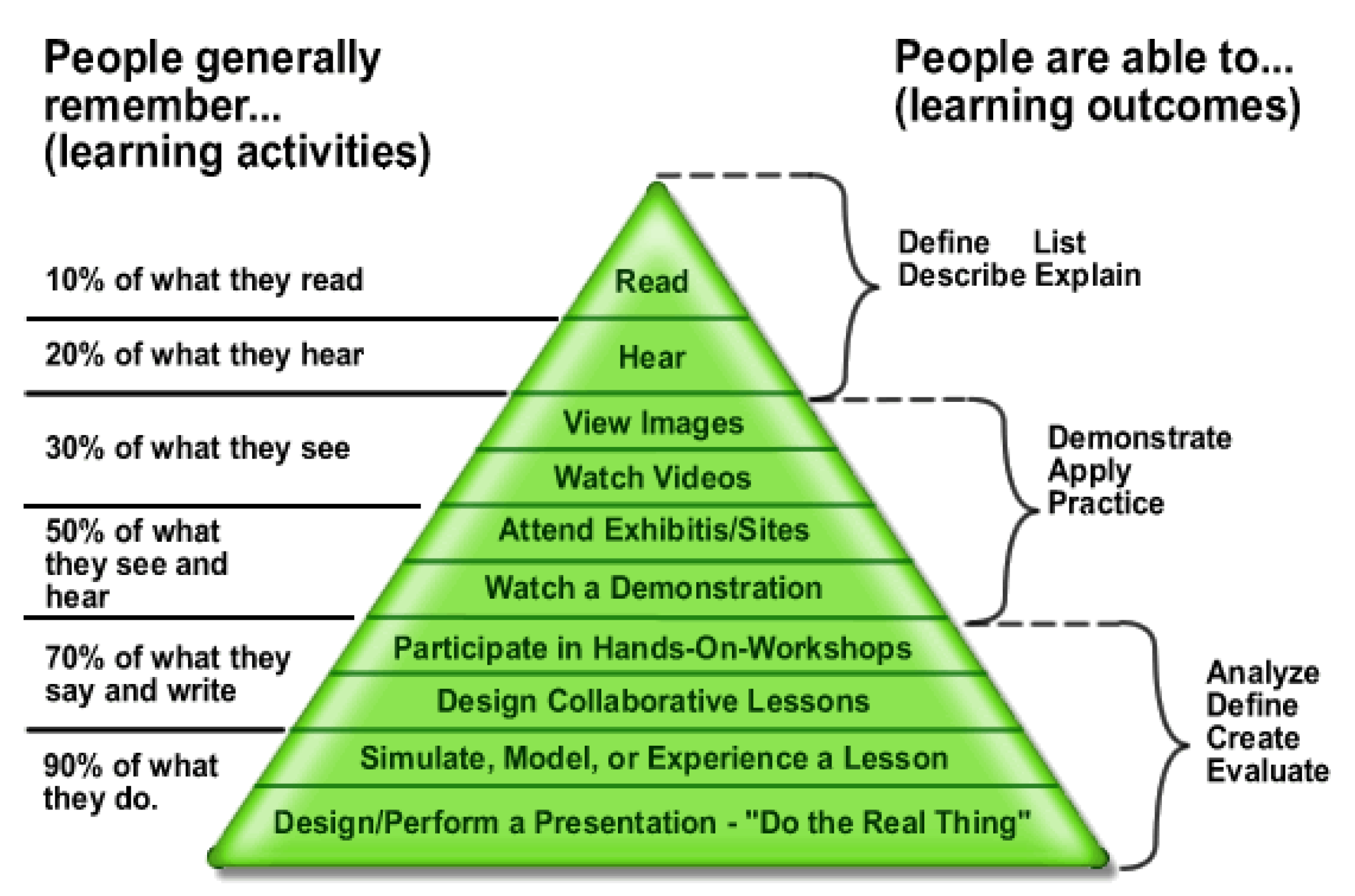
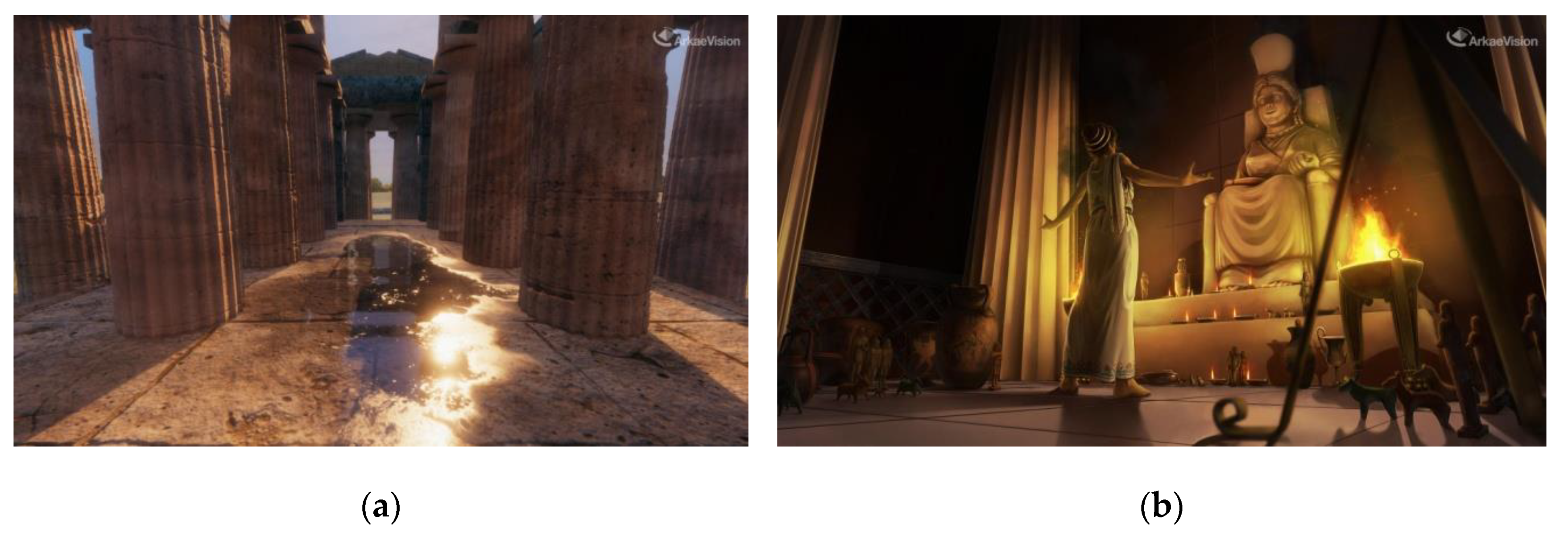
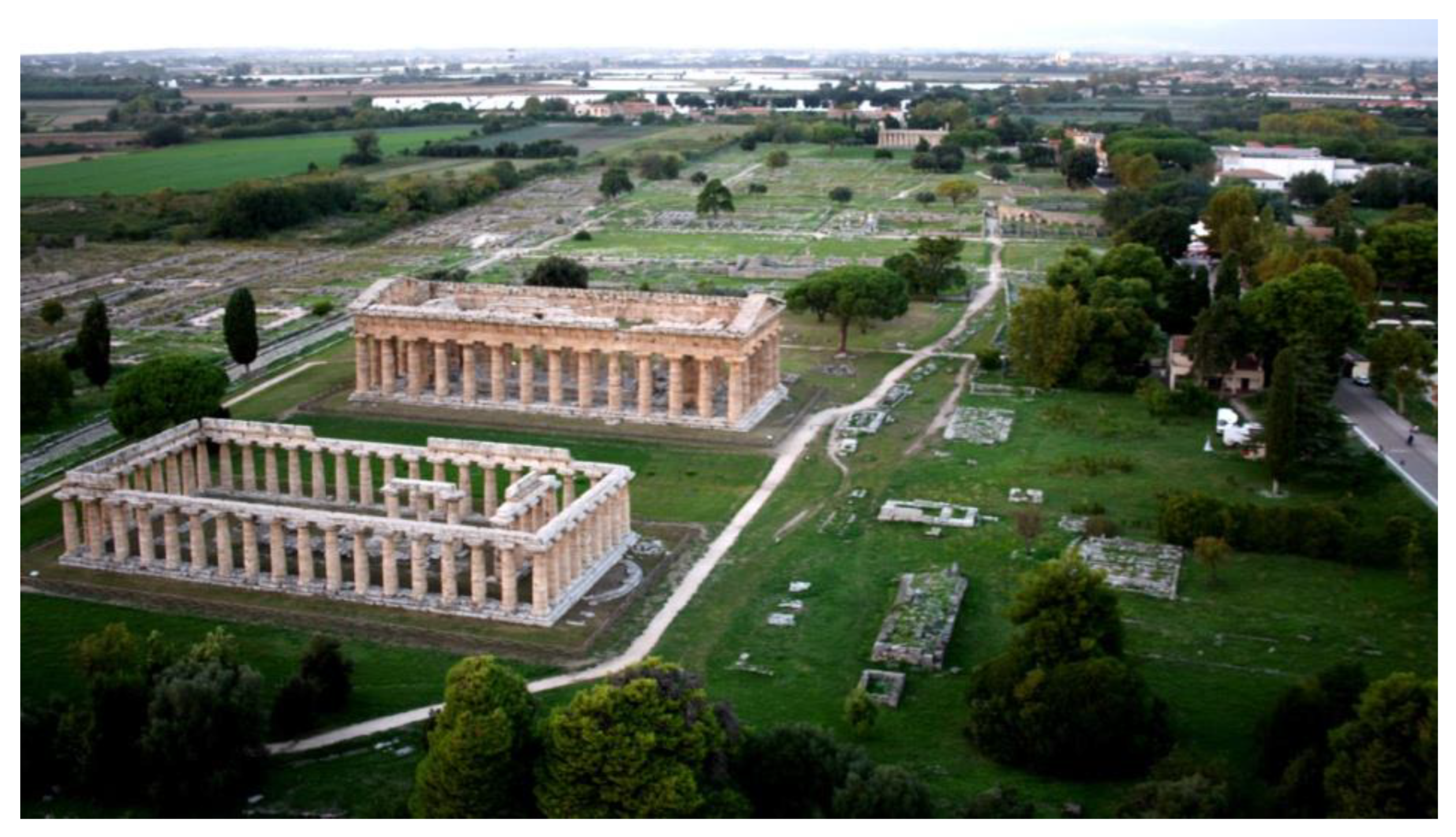
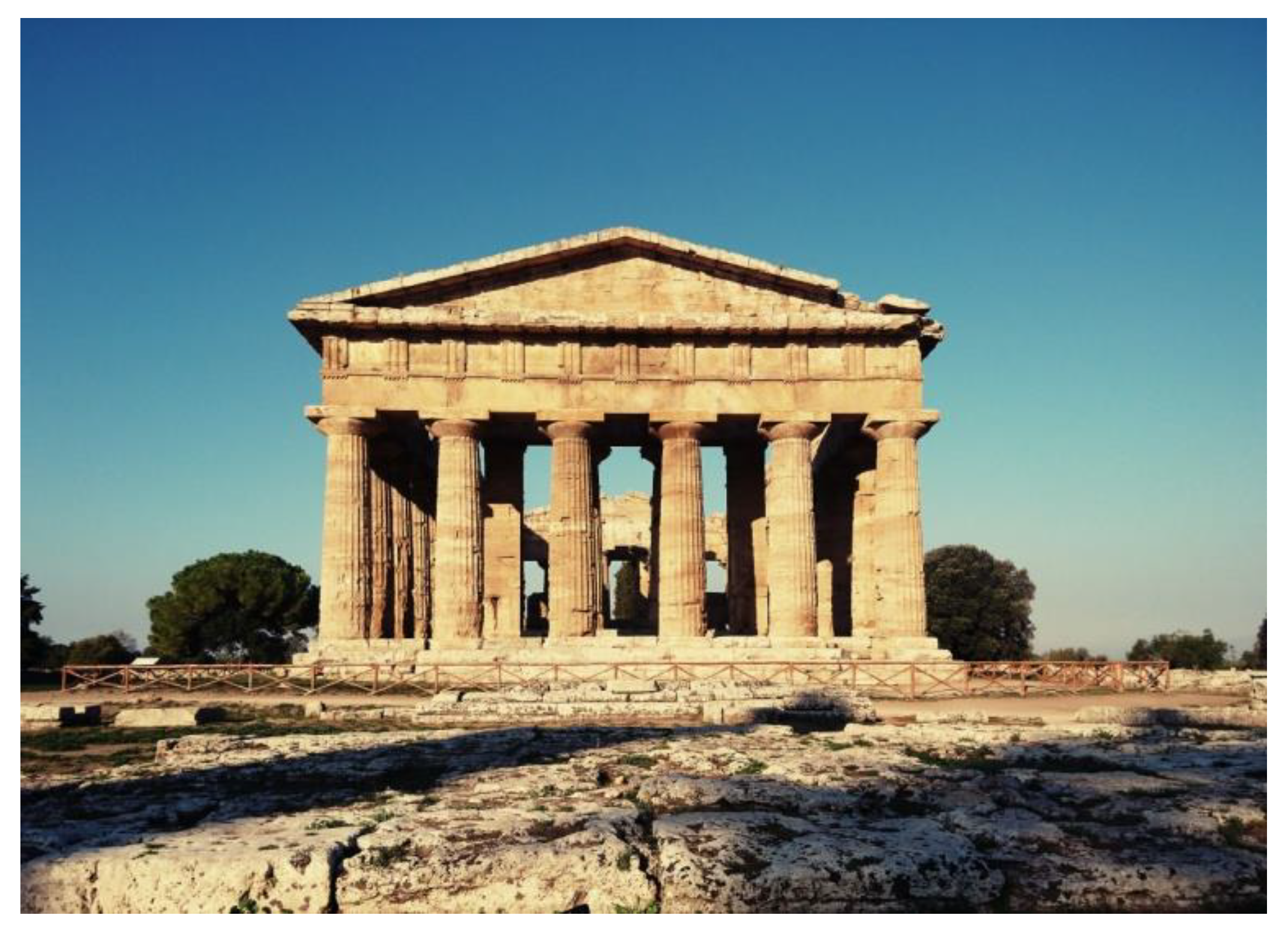
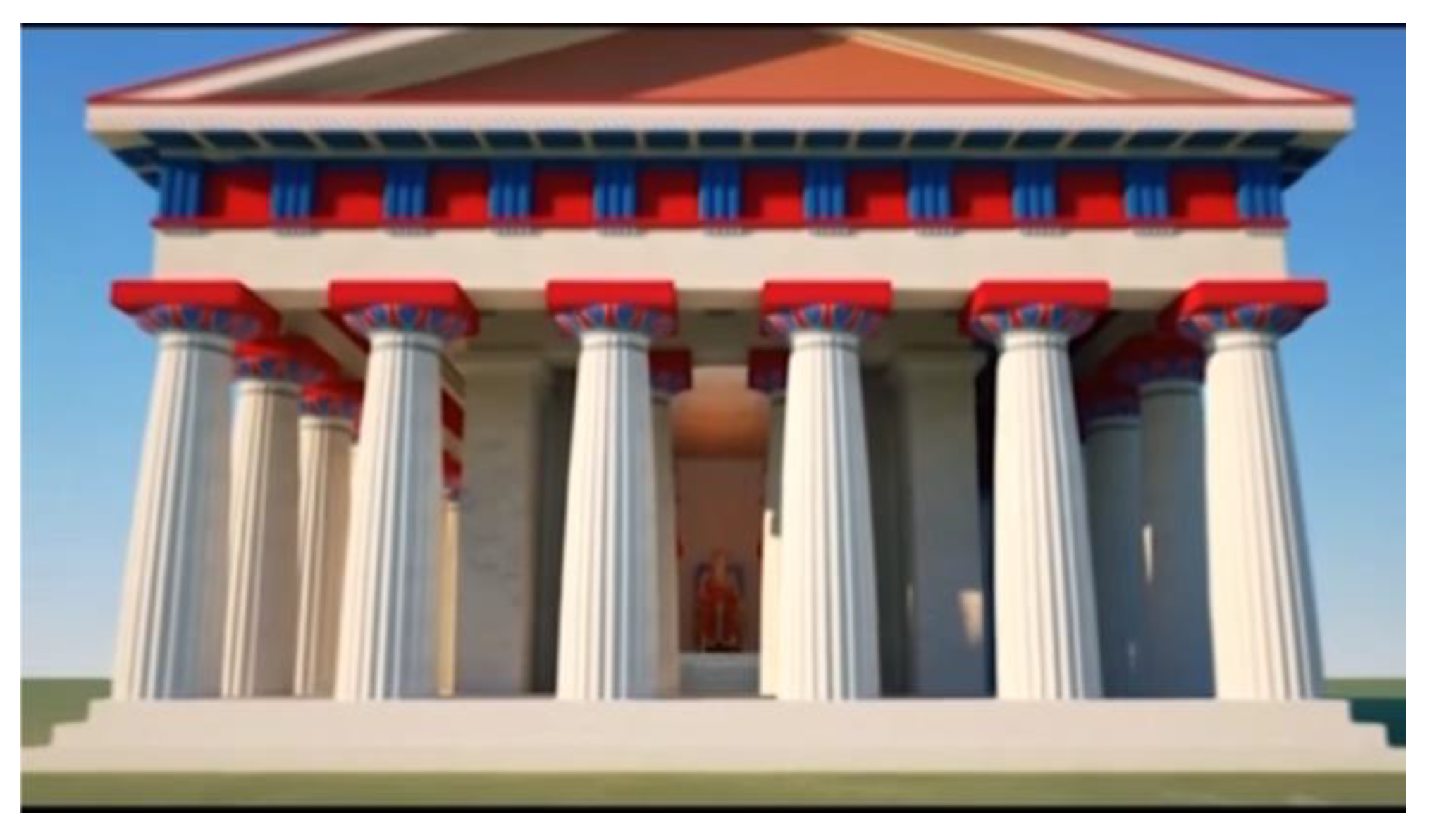
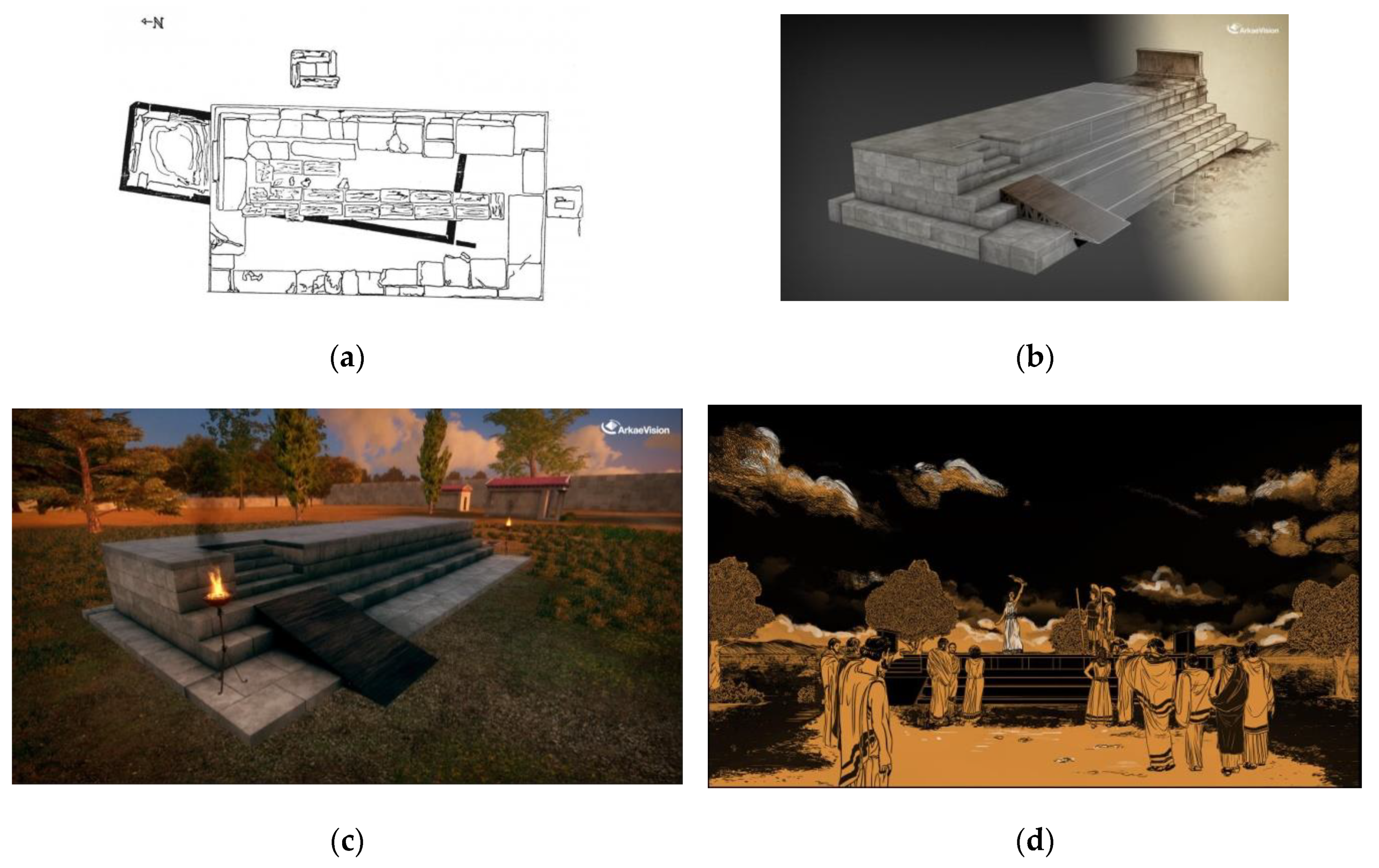
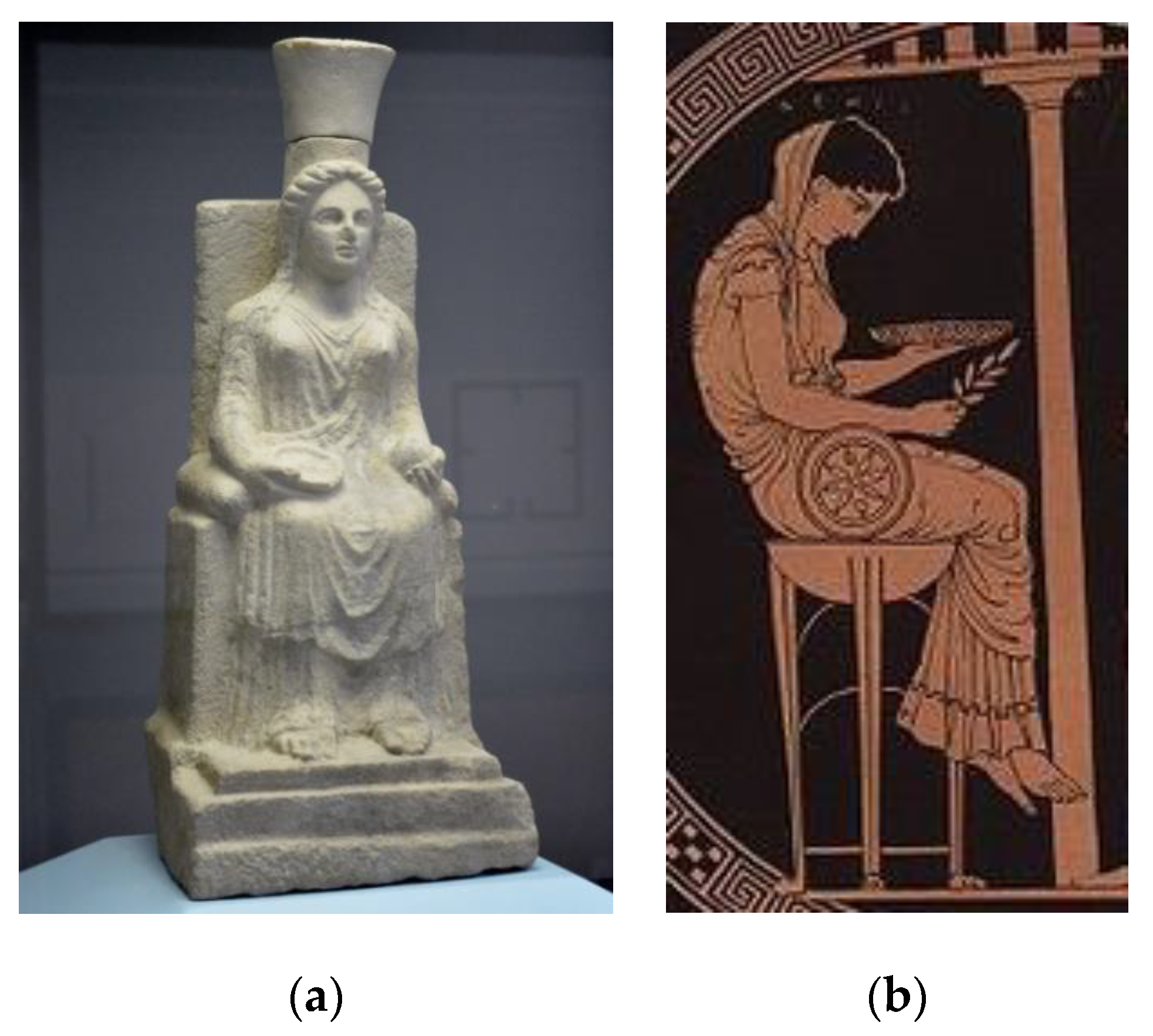

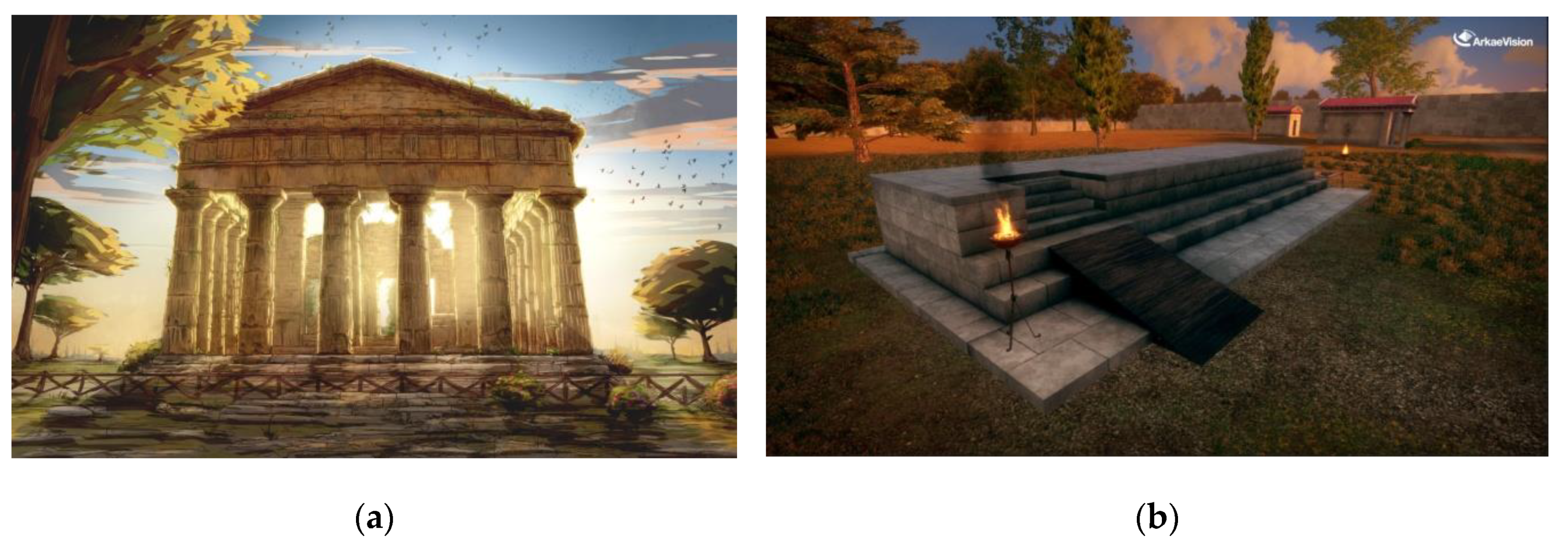
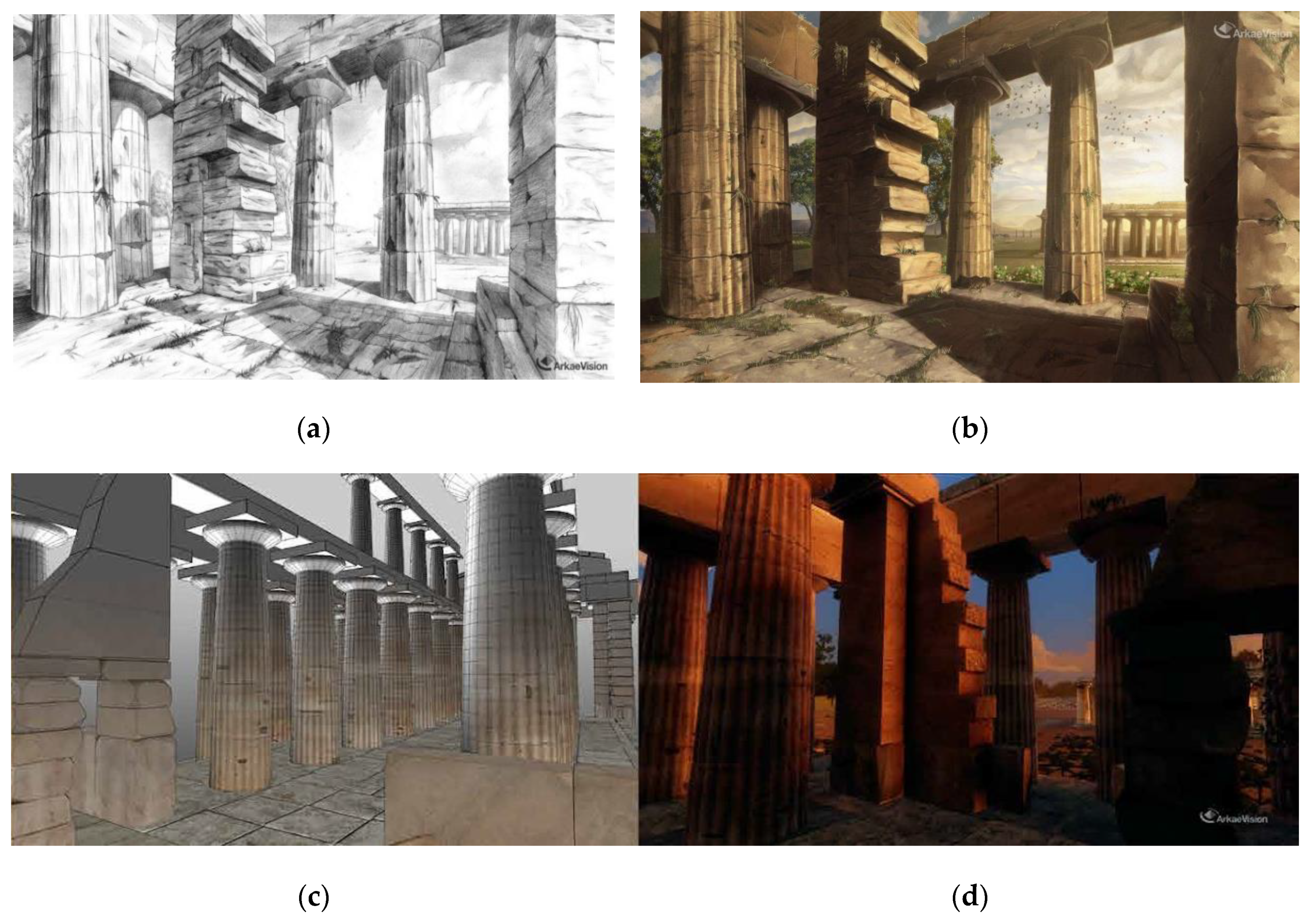


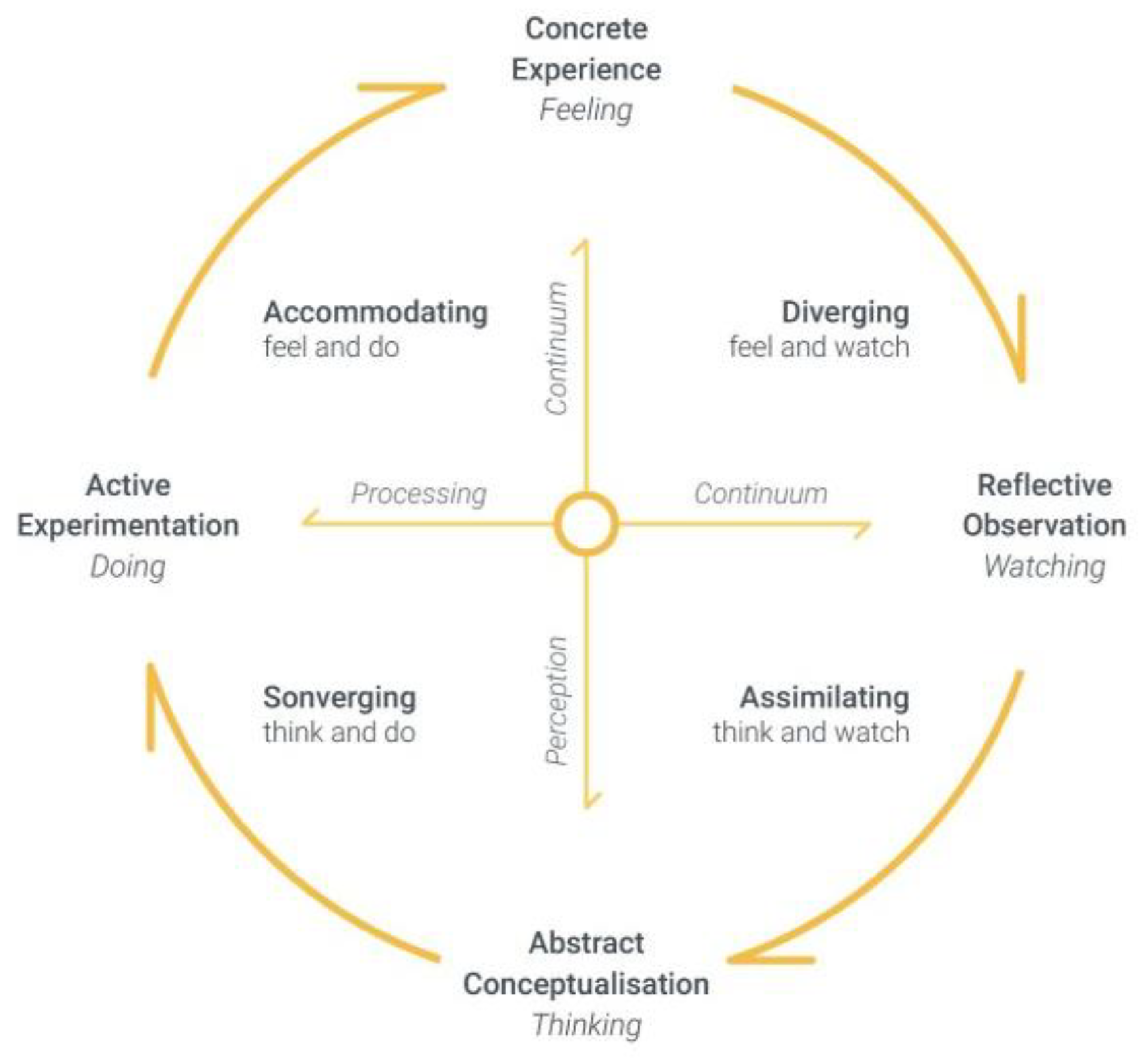
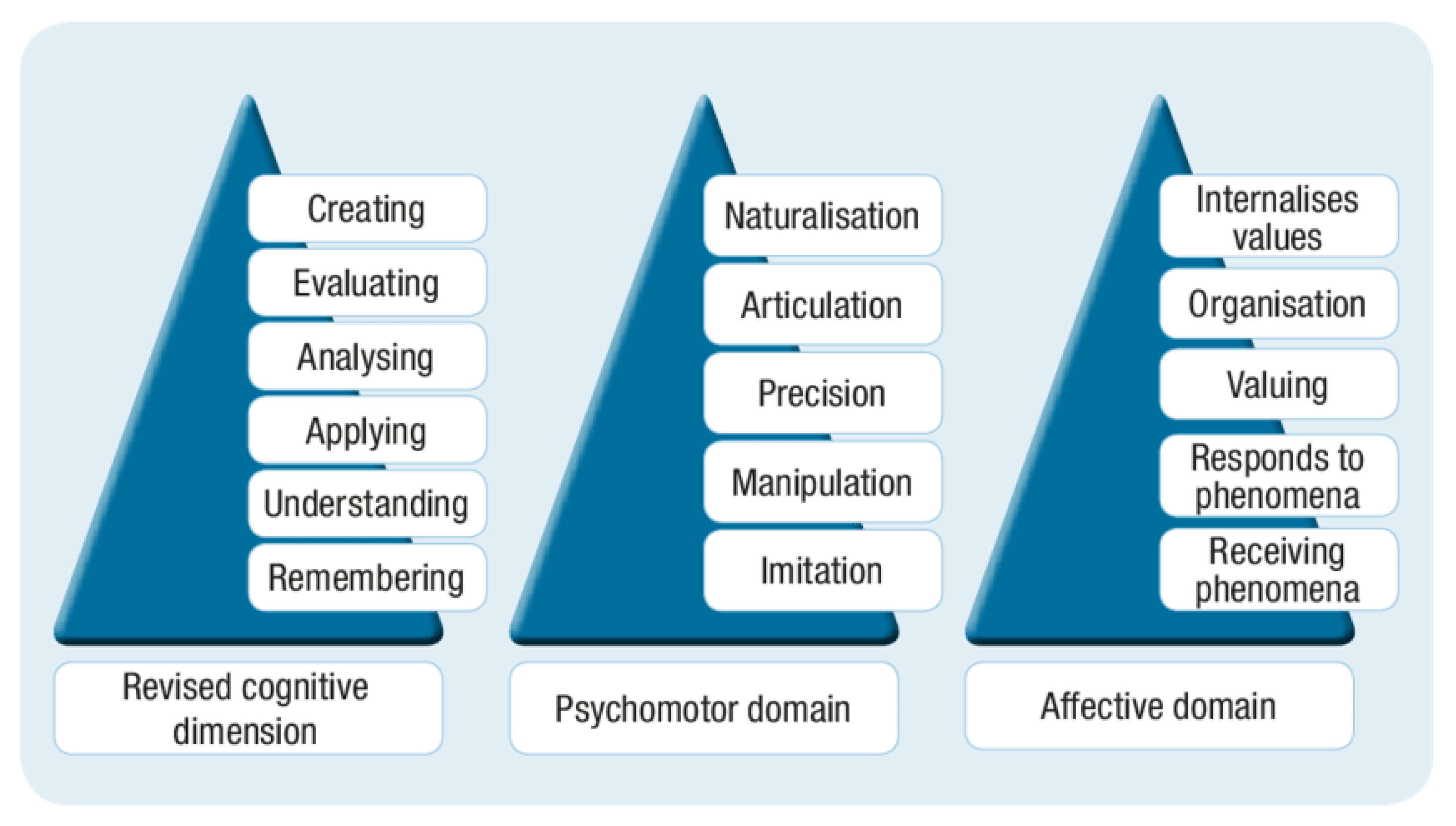
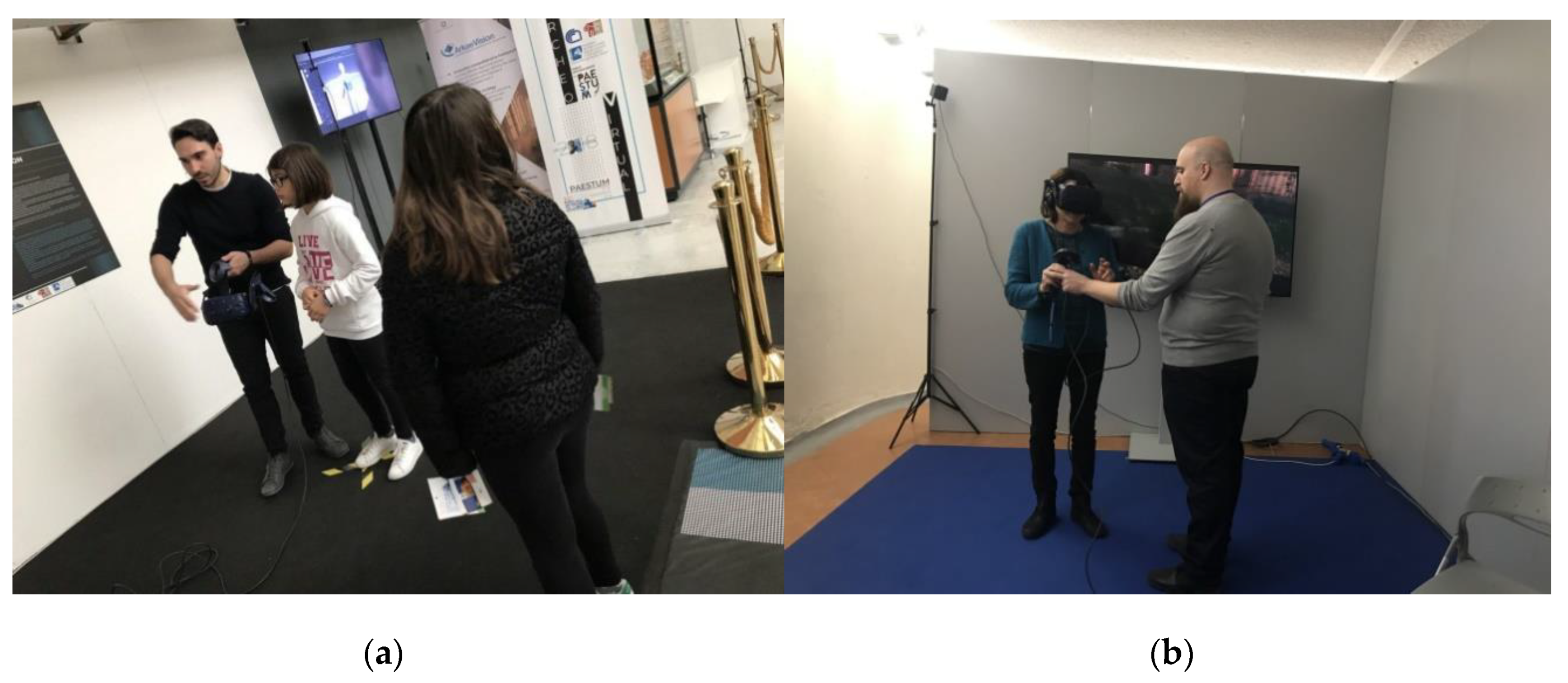
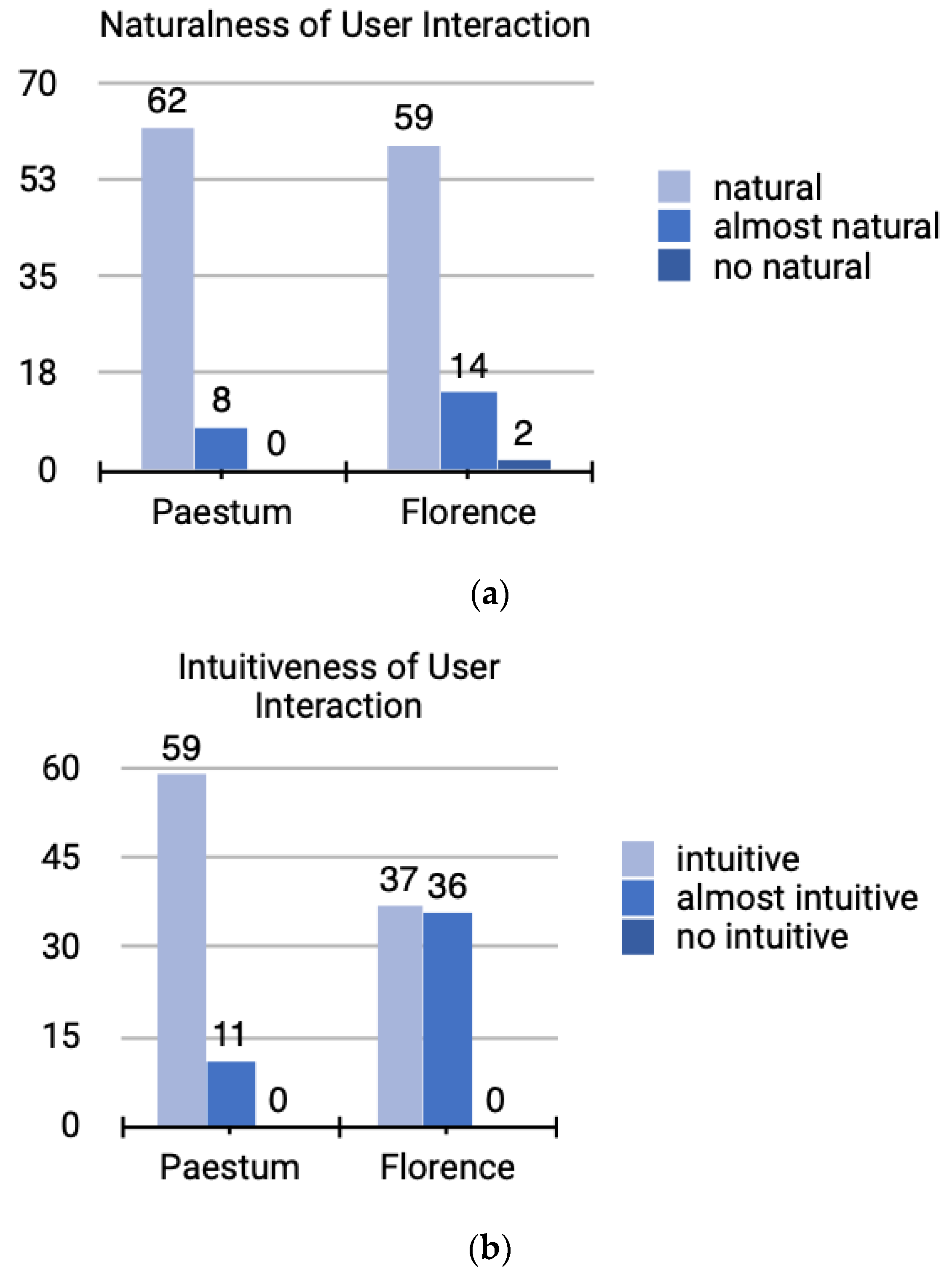
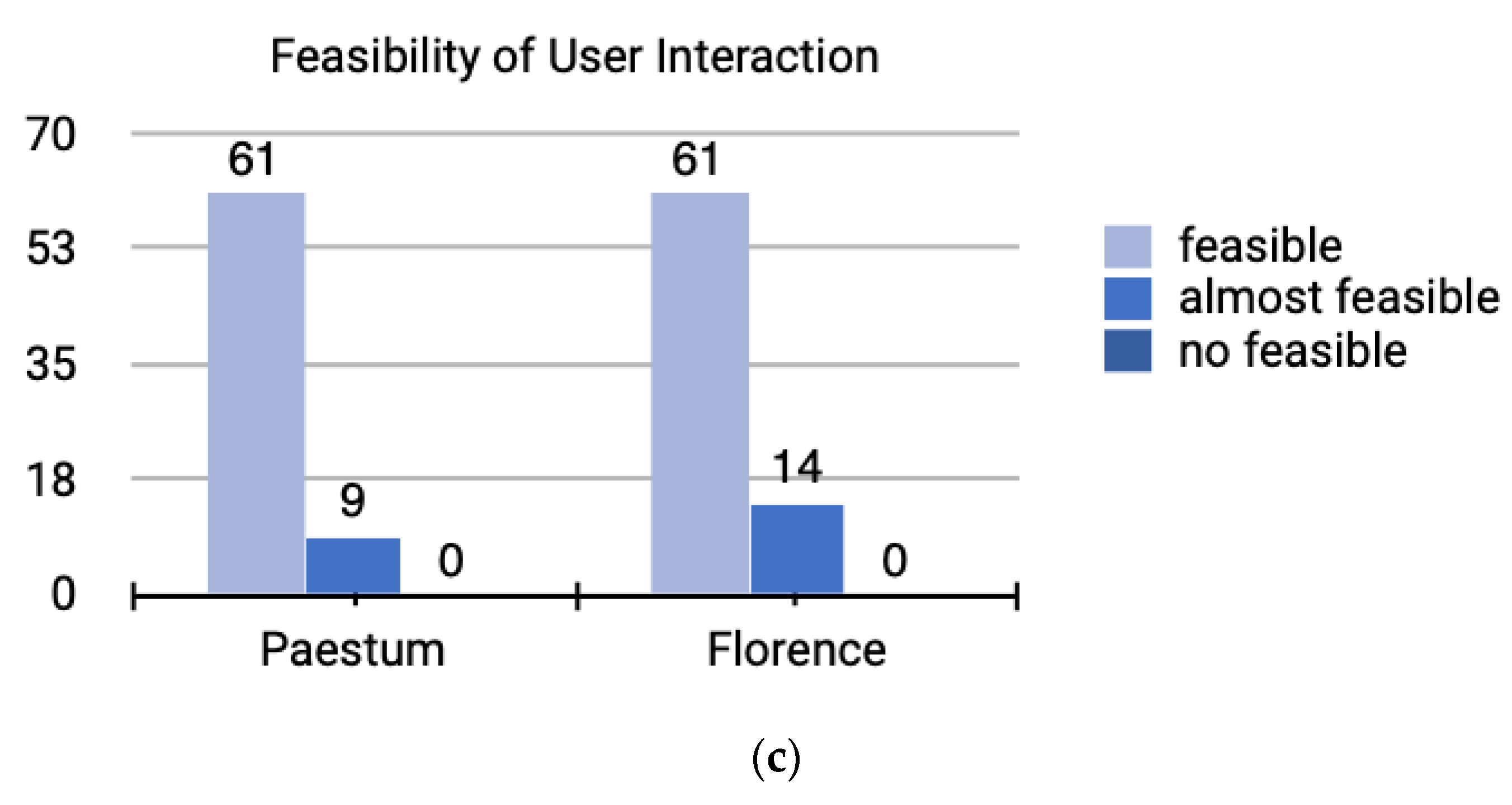
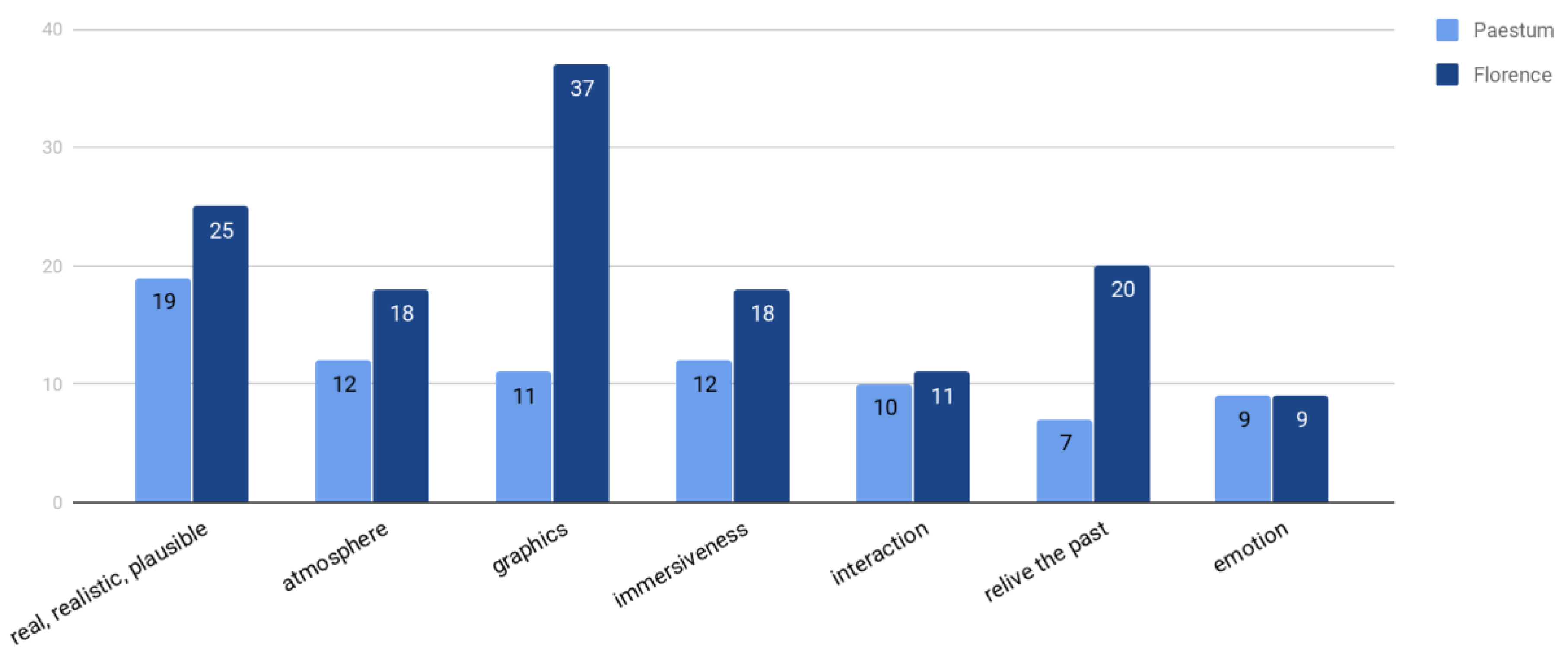
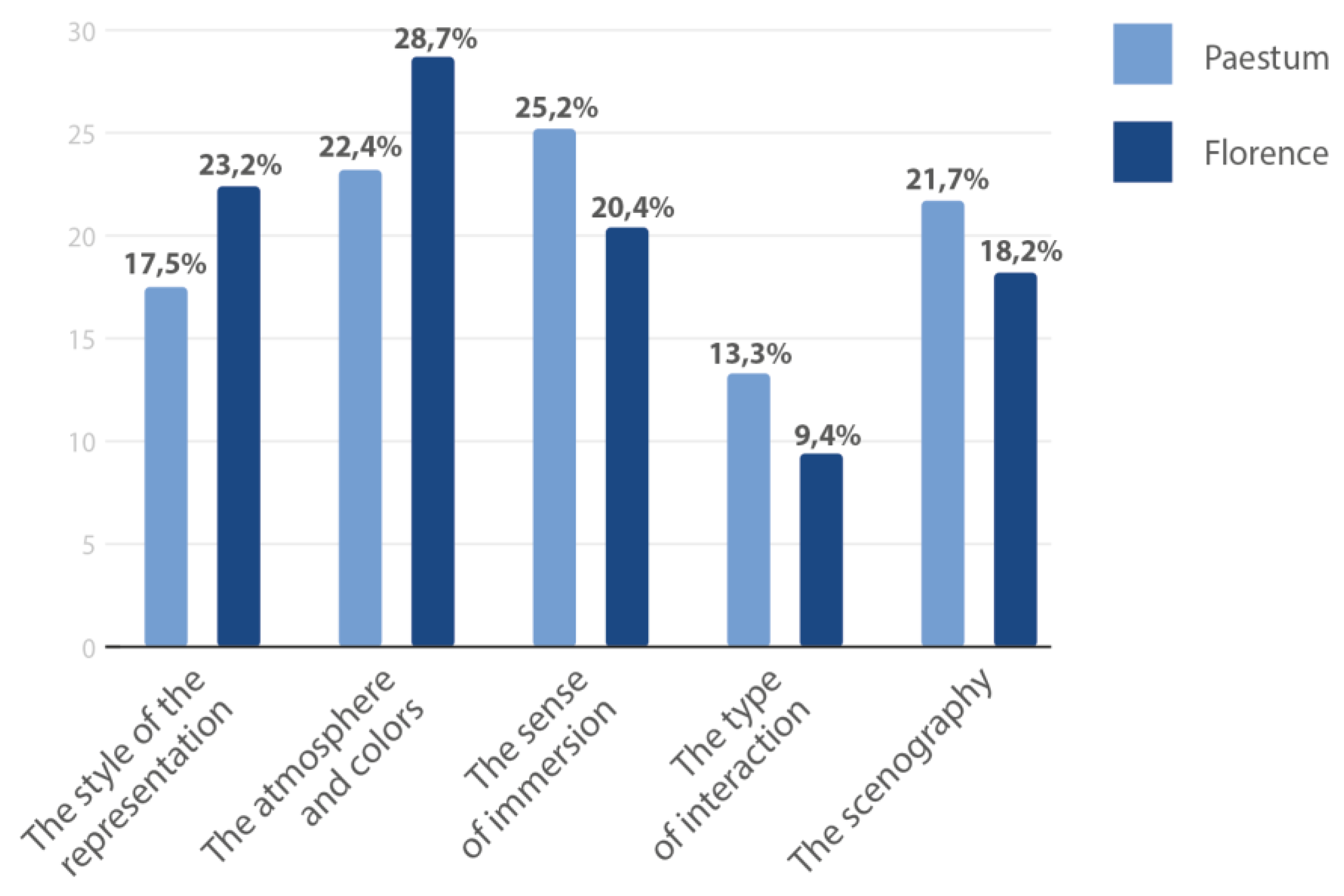
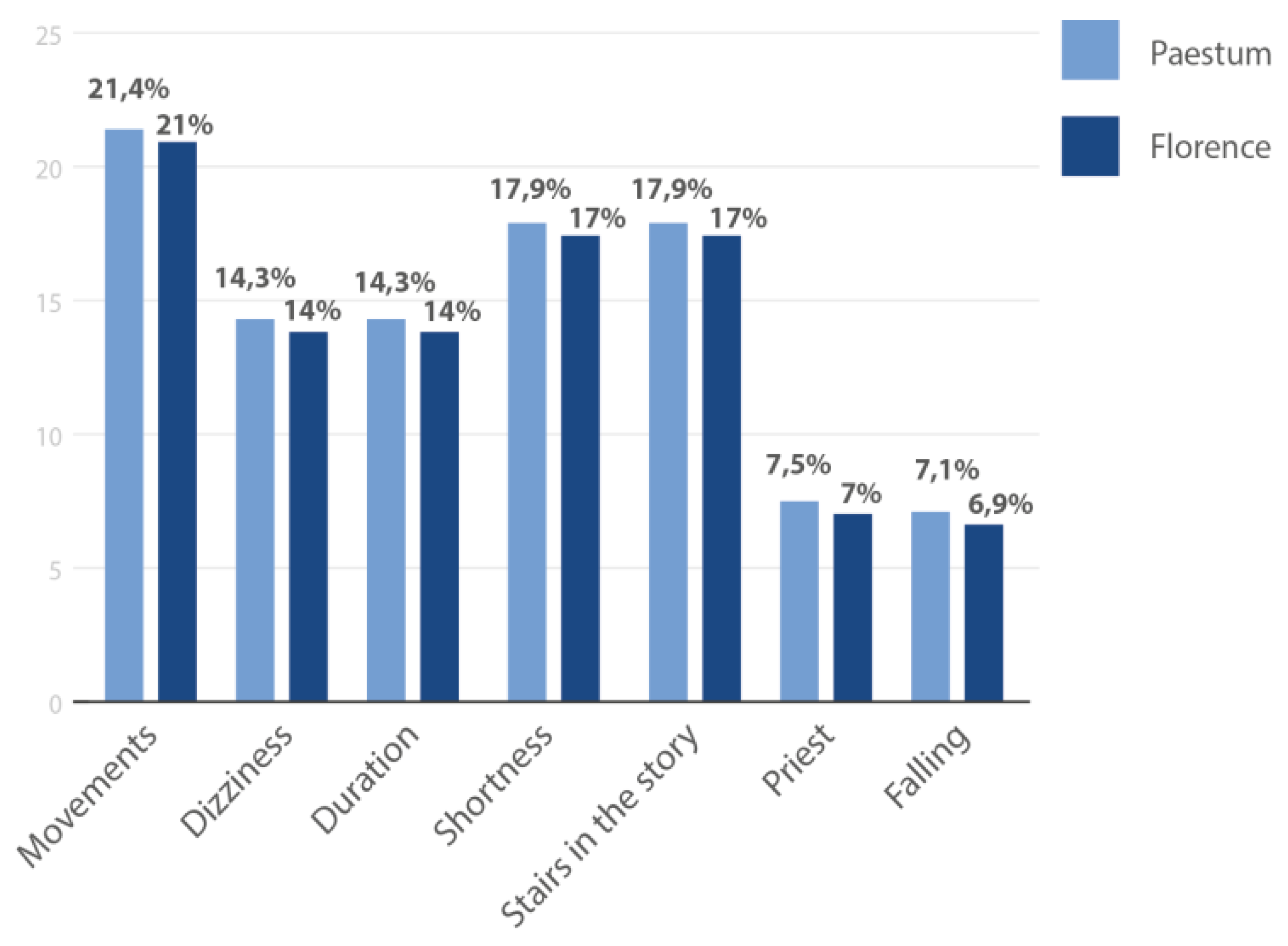
| Paestum | Florence | |
|---|---|---|
| period of the year | 15–18 November 2018 | 21–24 February 2019 |
| occasion | Archeovirtual | TourismA |
| total days of evaluation | 4 | 4 |
| time of VR experience | 7 | 10 |
| time of UX session | 15 | 23 |
| average age of users | 31 | 38 |
| observations | 70 | 75 |
| questionnaires | 70 | 75 |
© 2020 by the authors. Licensee MDPI, Basel, Switzerland. This article is an open access article distributed under the terms and conditions of the Creative Commons Attribution (CC BY) license (http://creativecommons.org/licenses/by/4.0/).
Share and Cite
Pagano, A.; Palombini, A.; Bozzelli, G.; De Nino, M.; Cerato, I.; Ricciardi, S. ArkaeVision VR Game: User Experience Research between Real and Virtual Paestum. Appl. Sci. 2020, 10, 3182. https://doi.org/10.3390/app10093182
Pagano A, Palombini A, Bozzelli G, De Nino M, Cerato I, Ricciardi S. ArkaeVision VR Game: User Experience Research between Real and Virtual Paestum. Applied Sciences. 2020; 10(9):3182. https://doi.org/10.3390/app10093182
Chicago/Turabian StylePagano, Alfonsina, Augusto Palombini, Guido Bozzelli, Maurizio De Nino, Ivana Cerato, and Stefano Ricciardi. 2020. "ArkaeVision VR Game: User Experience Research between Real and Virtual Paestum" Applied Sciences 10, no. 9: 3182. https://doi.org/10.3390/app10093182
APA StylePagano, A., Palombini, A., Bozzelli, G., De Nino, M., Cerato, I., & Ricciardi, S. (2020). ArkaeVision VR Game: User Experience Research between Real and Virtual Paestum. Applied Sciences, 10(9), 3182. https://doi.org/10.3390/app10093182







